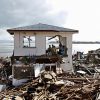
AsianScientist (Aug. 30, 2024) – Tropical cyclones in Southeast Asia are now forming closer to coastlines, intensifying more rapidly and lingering longer over land — all driven by climate change. These shifts significantly increase the risks for tens of millions of people living in coastal areas and leaving cities like Bangkok in Thailand, Hai Phong in Vietnam and Yangon in Myanmar vulnerable to unprecedented threats from more prolonged and intensified storms.
A recent study, co-led by researchers from Rowan University, United States; Nanyang Technological University (NTU), Singapore; and the University of Pennsylvania, United States, has highlighted this alarming trend. The study, part of NTU’s Climate Transformation Programme, found that climate change is altering the paths and behaviours of tropical cyclones in Southeast Asia.
Tropical cyclones typically form in the tropical zone near the equator, characterised by warm ocean waters, providing the necessary heat and moisture for these cyclones to develop and intensify.
“Southeast Asia has very densely populated coastlines, currently home to more than 70 percent of the global population that’s exposed to future sea level rise. When you’re looking at that densely populated coastline, and it’s a region affected by tropical cyclones, there’s a real risk, especially when those storms become more damaging and populations continue to grow,” said Andra Garner, lead author of the study and assistant professor at Rowan University’s School of Earth & Environment.
The study, published in the Nature partner journal Climate and Atmospheric Science highlights significant changes in tropical cyclone behaviour in Southeast Asia, such as they are increasingly forming near coastlines and moving slowly over land — factors that could pose new risks to the region.
The research is based on the analysis of over 64,000 modelled historic and future storms, spanning from the 19th century through the end of the 21st century. This study is the first to use data from multiple climate models to examine cyclones over three centuries.
According to the researchers, warming ocean waters around the world are fueling these tropical cyclones. The warmer they get, the more energy storms can draw from them.
“Tropical cyclones have caused torrential rains and severe flooding across Southeast Asia, prompting mass evacuations, destroying infrastructure and affecting the lives and livelihoods of thousands of people. Our study shows that as the cyclones travel across warmer oceans from climate change, they pull in more water vapour and heat. That means stronger wind, heavier rainfall, and more flooding when the typhoons hit land,” said professor Benjamin Horton, Director of NTU’s Earth Observatory of Singapore, and co-author of the study.
Unlike traditional studies of historical weather patterns and storms, the researchers tailored computer simulations to manipulate various factors, such as projected increases in human-caused emissions and their impact on a warming planet. These simulations provided critical insights into how climate change is altering where cyclones form, strengthen, slow down, and eventually dissipate.
“By examining storms over an extended period, our study delivers insights that can help governments prepare for future storms and guide community development planning. Leveraging nine global climate models, this study significantly reduces the uncertainty in predicting tropical cyclone changes, which has been a challenge in past studies using just a single model,” said Dhrubajyoti Samanta, senior research Fellow at NTU’s Earth Observatory of Singapore and co-author of the study.
“Conducting a long-term analysis allows for better understanding of both past and future changes to tropical cyclone tracks, which can inform coastal resilience strategies in both the near-term and more distant future,” added co-author Mackenzie Weaver, from the Department of Earth and Environmental Science at the University of Pennsylvania.
“There were two takeaways: First, we should be acting to reduce emissions, so we can curb the impacts of future storms. Second, we should be acting now to protect those coastlines for the future, which will likely see some worsened tropical cyclone impacts regardless of future emissions,” said Garner.
—
Source: Rowan University ; Image: ymphotos/Shutterstock
You can find the article at: Changes to tropical cyclone trajectories in Southeast Asia under a warming climate
Disclaimer: This article does not necessarily reflect the views of AsianScientist or its staff

